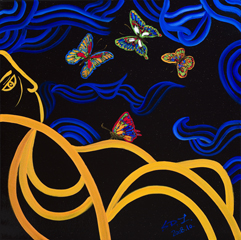Selected into
VI Edizione Premio OpenArt 2009,
Margutt Arte, Italy
Organizer: Margutt Arte
Date: 16 Jan, 2009 ~ 18 Jan, 2009
Place: Sale del Bramante, Santa Maria del Popolo, Piazza del Popolo, Roma
Summary of Organizer:
Margutt Arte takes a three-day OpenArt annual exhibition in January of every year in Bramante Gallery (Sale del Bramante).
|

Awakening / I Am Butterfly (7)
|
|
Summary of Exhibition Venue: Piazza del Popolo & Santa Maria del Popolo
Piazza del Popolo: Located in Roma, Italy, Piazza del Popolo is an oval-shaped public square composed of two semicircles. Once the place of public social gatherings, the square was redesigned in 1820 by famous architect Giuseppe Valadier into its neoclassical style as it appears today. The square is surrounded by many well-known buildings, including a 36 meter high cross-tipped obelisk in the center of Piazza brought back to Rome from Heliopolis in Egypt by order of Emperor Augustus in celebration of Roman conquest of Egypt, also as the first obelisk ever brought back to Rome from Egypt.
Santa Maria del Popolo: To the north of Piazza del Popolo stands Santa Maria del Popolo, the most ancient building in the square existing even prior to the square. The Piazza del Popolo takes its name from this church.
In 1099, a chapel for Virgin Mary was built by Pope Paschal II and the chapel received the name del Popolo ("of the people") since the people of Rome funded the building. In 1227 ~ 1241, the chapel became a church by will of Pope Gregory IX, and the expansion of the church was also undertaken. In 1472 ~ 1479, Santa Maria del Popolo was reconstructed by Baccio Pontelli and Andrea Bregno, commissioned by Pope Sixtus IV, creating the first example of Italian Renaissance church.
In 1550 ~ 1509, Bramante modified the chanting seats and the semicircle niche. In 1655 ~ 1667, Vatican’s leading architect Giovanni Lorenzo Bernini was asked by Pope Alexander VII to add Baroque style to the interior design in the church of a Renaissance appearance to become what appears today.
The church stood through long years with many artworks designed or created by the prominent artists invited from each generation of its history, leaving complete traces of various artistic styles from different periods. The renowned artists ever involved in the church design include Raphael, Giovanni Lorenzo Bernini, and Caravaggio, etc.
|



